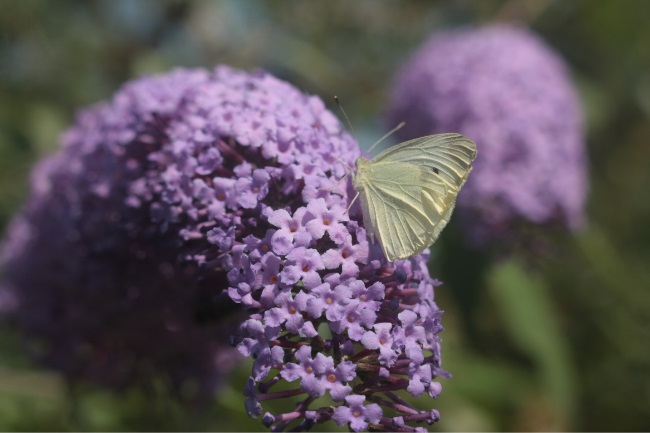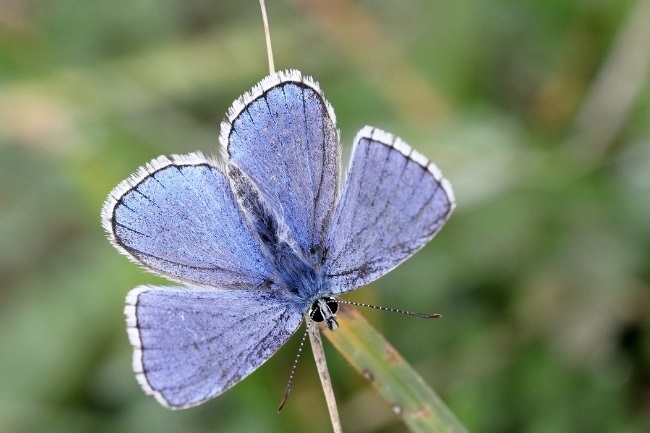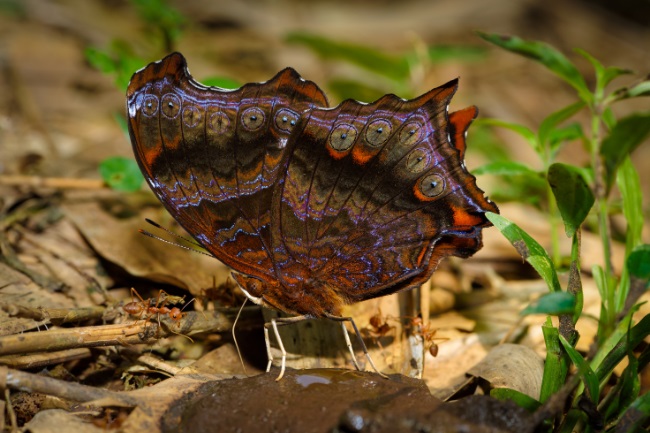Butterflies get their colours in two ways; through pigmentation and through refraction. The first uses certain chemicals to make their wings appear in different colours, the second uses different structures to refract the light, giving off vibrant and iridescent colours.
Contents
Flights of fancy

Butterflies have been described by some as aerial flowers. Their diverse colours and patterns have made them beloved by artists and used as inspiration for anything from fashion to interior design.
In every country in which butterflies are found there is a myriad of different colours, tones and patterns to be seen on their wings. From brilliant blue eyespots to striking black and white stripes, to burning oranges and reds.
It can seem amazing that so many different shades and patterns have come to be displayed on one group of insects, and there are certainly few others that can boast such a kaleidoscope of colours.
It is their amazing beauty that has made them so popular with collectors, and which has encouraged so many people to try to protect and look after them. It is both the jewel that people wish to take from them and the treasure they try to keep safe.
Also read: Can a Butterfly’s Wings Grow Back? (Explained)
How do butterflies get their colours?
There are two main ways that butterflies get their colours, from pigmentation and refraction.
| Color Source | Examples |
|---|---|
| Pigments | Melanin, carotenoids, and other pigments |
| Structural Colors | Microscopic structures and light interference |
Pigmentation
Pigmentation is the method by which most plants and animals get their colours. This is where chemicals provide colour to an object. Colour, as we perceive it, is caused by certain light waves being reflected back off an object while others are absorbed.
An object that appears black to us for example absorbs all light waves, so nothing is reflected back for our eyes to pick up. A white object, by contrast, reflects everything. When we dive down into the sea blue light waves are able to penetrate the water much better than green or red waves, which is why the world around us takes on a blue tinge.
Different chemicals can provide different colours. In some cases, the colour of those chemicals may just be a byproduct. For example, chlorophyll in leaves is green, giving most leaves a green colour. The leaves do not intend to be green but the chlorophyll is doing a vital job by absorbing sunlight and helping them to produce food for the plant.
In other cases, the chemical is there precisely because it can make a colour. For example, many ladybirds are red as this helps them to tell predators that they are poisonous and unpleasant to eat. They do not require the red pigment for any other purpose than for it to be a colour.
Also read: A List of 5 Centipedes with Blue Legs
Refraction

Refraction is a fascinating natural phenomenon and gives us the beautiful greens and blues of a peacock’s tail, the shimmer of a mother of pearl and the wonderful flash of a kingfisher’s back. It also provides an extra bit of shimmer to many species of butterflies.
Refraction is caused by light being reflected back and multiplied by transparent structures. By reflecting the colours back multiple times it causes them to intensify and results in the iridescence, that metallic shimmer we sometimes see in nature.
The morpho butterfly is a classic example of this, with its brilliant blue wings, as is the smaller and more delicate green hairstreak with its metallic green shimmer.
Scaly butterflies
We may tend to think of the butterfly’s wings as being ‘painted’ but in fact, they are much more like a wall, built up in blocks. Attached to the wings are many hundreds of tiny scales, evolved from hairs. These carry the colour pigments and the structures that cause iridescence. Like building up a picture on an old television screen, they form together to create overall patterns across the wings.
A useful beauty
We tend to think of butterflies as beautiful for the sake of beauty, but the colours on a butterfly’s wings have a very important job to do. Depending on the species, or even on how the butterfly is displaying itself, the wings can act as a camouflage, a deterrent or a seduction.
Camouflage

Many animals have adapted their looks over the millennium to help hide themselves. Hiding can either help them to avoid their predators or to sneak up on their prey. Many butterflies have bright inner wings but then opt for the outsides to be much darker and less obvious. This means that if they close their wings they are able to camouflage themselves, and disappear.
Many species have patterns and colours that mimic bark or leaves, and even the shape of the wings can help to build on this disguise. The brimstone butterfly looks almost indistinguishable from the dried leaves around it when it closes its wings to rest, while the comma fades perfectly into the bark of a tree it is resting on.
Such simple tricks may seem unnecessary to us when we observe these little insects, but to a butterfly, it can be the difference between life and death.
Also read: Can Butterflies Sting? How do They Protect Themselves?
Deterrent
While some butterflies try to hide away others stand bold and strong, painted almost in war paints as they dare their predators to do their worst. Bright reds, yellows and oranges, as well as striking patterns, are all used to warn that a butterfly is poisonous to eat, and not worth the time of a hungry bird or other predator.
Some butterflies, however, like to cheat and will copy these fancy colours without having the goods to back up the threat. This way they save energy on producing toxic substances but are more likely to be left alone by their enemies.
Seduction
Colours are also a good indication of an animal’s health, with bright colours often indicating they are stronger and more able to produce healthy offspring. This can be one of the ways that a female may judge whether a male is worth mating with.
Also read: Do Butterflies Mate for Life? Eternal Love or…
Beauty is in the eye of the beholder
We may all believe that butterflies are beautiful, but like flowers, their beauty is more functional than we would like to admit. If butterflies had no use for their colours they wouldn’t have evolved them, and perhaps then all we would see is fluttering white insects, rather than a full array of colour.

